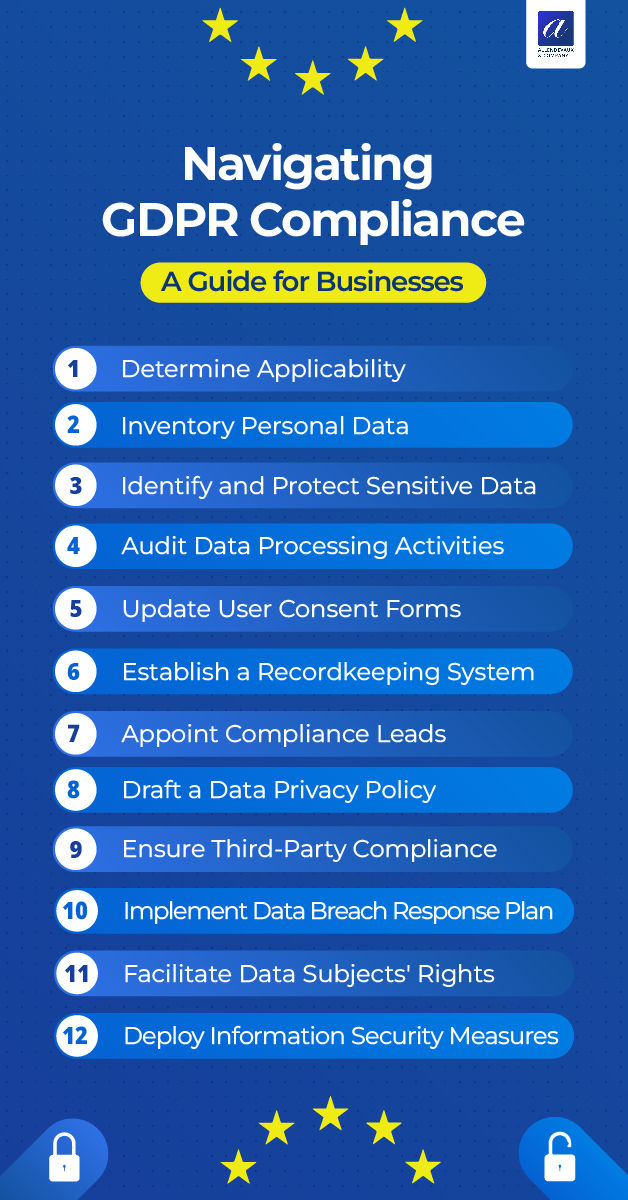Navigating GDPR Compliance: A Guide for Businesses by Allendevaux
- bakhshishsingh
- Mar 15, 2024
- 3 min read
In today's interconnected world, the General Data Protection Regulation (GDPR) stands as a cornerstone of data privacy and security, affecting businesses far beyond the borders of the European Union (EU). At Allendevaux, we're committed to helping you navigate the complexities of GDPR compliance with clarity and confidence. Here's a comprehensive guide tailored for businesses striving to align with GDPR standards.

1. Determine Applicability
First and foremost, understanding whether GDPR applies to your operations is crucial. This regulation impacts any entity that processes personal data of EU residents, not just those within the European Economic Area (EEA). If your business offers goods or services to EU residents or monitors their activities, GDPR compliance is mandatory.
2. Inventory Personal Data
A thorough inventory of personal data is the foundation of GDPR compliance. Identify what data you collect, how it's processed, and where it's stored. Leveraging data protection solutions can streamline this process, ensuring a clearer understanding of your data landscape and how to protect it.
3. Identify and Protect Sensitive Data
GDPR mandates heightened protections for sensitive data categories, including biometrics and children's information. Ensuring explicit consent or parental approval for processing such data is essential. It's not just about compliance but about respecting the privacy and rights of individuals.
4. Audit Data Processing Activities
Review your data processing activities to ensure they have a legal basis and adhere to GDPR's core principles, such as purpose limitation and data minimization. This step is vital for maintaining the legality and integrity of your data handling practices.
5. Update User Consent Forms
Under GDPR, consent must be clear, affirmative, and freely given. Revise your consent forms to include transparent explanations and opt-in mechanisms, thus empowering users and reinforcing trust in your data practices.
6. Establish a Recordkeeping System
For organizations with more than 250 employees or those processing high-risk data, implementing a robust recordkeeping system is imperative. It not only aids in tracking compliance efforts but also serves as proof of your commitment to data protection.
7. Appoint Compliance Leads
Designating a Data Protection Officer (DPO) is mandatory for certain organizations. This role is central to overseeing GDPR compliance, from risk assessments to employee training. Even if not required, appointing a compliance lead can significantly streamline your GDPR journey.
8. Draft a Data Privacy Policy
Your data privacy policy is a public declaration of your data handling practices. Ensure it's clearly written and easily accessible, reflecting your commitment to transparency and compliance.
9. Ensure Third-Party Compliance
The responsibility of GDPR compliance extends to your partners and vendors. Establish clear contractual agreements detailing data handling responsibilities to avoid penalties associated with third-party noncompliance.
10. Implement Data Breach Response Plan
Be prepared to act swiftly in the event of a data breach, with a plan that includes notifying authorities within 72 hours and affected individuals if there's a high risk to their rights and freedoms.
11. Facilitate Data Subjects' Rights
Simplify the process for individuals to exercise their rights, such as accessing, correcting, or deleting their data. Streamlined and user-friendly mechanisms are key to compliance and enhancing user trust.
12. Deploy Information Security Measures
Adopt both technical and organizational measures to protect data, embracing the principle of data protection by design and default. This proactive approach not only aligns with GDPR requirements but also strengthens your cybersecurity posture.
At Allendevaux, we understand the significance of GDPR compliance in today's digital landscape. By following this guide, you can better navigate the complexities of data protection, ensuring your business not only complies with GDPR but also fosters a culture of privacy and security. For more insights and support on your GDPR compliance journey, visit our website or contact our team of experts. Together, we can turn compliance into an opportunity to enhance trust and security in the digital age.





When you share photos online, you might be sharing more information than you realize. EXIF data embedded in images can include your camera model, settings, and sometimes even GPS location. If you're concerned about privacy, using an Online Metadata Remover can help you strip this information before you post. It’s a quick and easy way to protect your identity and personal details, ensuring you only share the image itself and not potentially sensitive hidden data. It takes just a few seconds but can significantly enhance your online privacy.